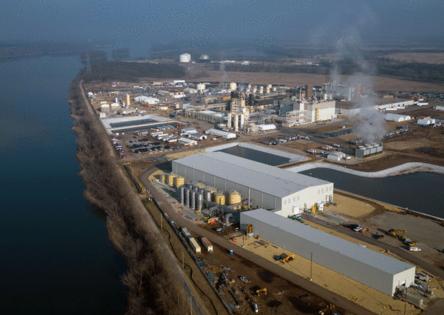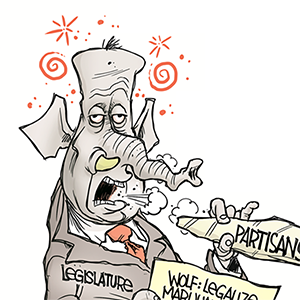Trump EPA gutting limits on certain forever chemicals, delaying deadline to reduce others
Published in News & Features
In a rare acceptance of regulations adopted during the Biden administration, the Trump-led Environmental Protection Agency is backing the first national limits on a pair of toxic forever chemicals contaminating the drinking water of most Americans.
But the Trump EPA wants to eliminate standards for a handful of replacement chemicals that appear to be just as dangerous, if not more so.
The EPA’s proposed changes, announced Wednesday, reflect bipartisan political concern about perfluorooctane sulfonic acid (PFOS), used by 3M for decades to make Scotchgard stain repellent, and perfluorooctanoic acid (PFOA), sold to DuPont by 3M to manufacture Teflon coatings for cookware, clothing and wiring.
Based on years of research, EPA scientists concluded in 2022 there is no safe level of exposure to either chemical.
Yet the Trump administration attempted to throw a bone to chemical manufacturers and water utilities by delaying the agency’s deadline to reduce PFOS and PFOA in tap water until 2031, and by gutting limits on four other versions of forever chemicals.
Some of the chemicals build up in human blood, cause cancer and other diseases and take years to leave the body. Others, known collectively as PFAS — short for per- and polyfluoroalkyl substances — threaten human health because people are constantly exposed to them through consumer products, the food they eat, the air they breathe and the water they drink.
Lee Zeldin, President Donald Trump’s EPA administrator, vowed last month to take more aggressive action to reduce PFAS exposures. Zeldin and other Trump political appointees also are moving to eliminate the EPA’s chemical safety office as part of a dramatic reduction in the agency’s personnel and responsibilities.
“We are on a path to uphold the agency’s nationwide standards to protect Americans from PFOA and PFOS in their water,” Zeldin said Wednesday in a statement. “At the same time, we will work to provide common-sense flexibility in the form of additional time for compliance.”
Though the original Scotchgard and Teflon chemicals are no longer made in the United States, they are called forever chemicals because they don’t break down. Both have been found in the drinking water of 200 million Americans, including 6 out of 10 Illinoisans.
Under President Joe Biden, the EPA in April 2024 limited concentrations of PFOS and PFOA in tap water to 4 parts per trillion — an amount the agency said is the lowest at which the chemicals can be accurately detected. Three replacements — PFHxS, PFNA and GenX — were limited to 10 parts per trillion, and the agency required utilities to use a “hazard index” to monitor mixtures of those chemicals, as well as a fourth, PFBS.
“There’s no doubt that these chemicals have been important for certain industries and consumer uses,” then-EPA Administrator Michael Regan told reporters at time. “But there’s also no doubt that many of these chemicals can be harmful to our health and our environment.”
Forever chemicals end up in lakes, rivers and wells after flushing through sewage treatment plants and spreading from factory smokestacks. They also leach out of products such as carpets, clothing, cookware, cosmetics, dental floss, fast-food wrappers, firefighting foam, food packaging, microwave popcorn bags, paper plates, pizza boxes, rain jackets and ski wax.
Based on limited testing of tap water by the EPA and some states during the past decade, thousands of utilities still face expensive upgrades to their treatment plants. For now, it appears Chicago and other Illinois communities that depend on Lake Michigan for drinking water will not be required to do anything other than test for the chemicals.
Testing by the Chicago Department of Water Management and the Illinois EPA detected PFOS in treated Lake Michigan water but at levels below the federal standards supported by the Trump administration.
Peoria, where PFAS have been detected as high as 12.9 parts per trillion, is the largest Illinois city that will need to improve its treatment processes, according to a Chicago Tribune analysis of water testing conducted by state investigators.
In the Chicago area, the state’s testing found PFAS levels exceeded federal standards in Cary, Channahon, Crest Hill, Fox Lake, Lake in the Hills, Marengo, Rockdale, South Elgin and Sugar Grove. All of those communities rely on wells; several have stopped using their most contaminated sources of drinking water.
Though the forever chemicals the Trump administration is seeking to exempt have rarely been detected in Illinois, they are huge problems in other states where replacements for the original Scotchgard and Teflon chemicals have been produced, including North Carolina.
“This current administration promised voters it would ‘Make America Healthy Again,’ but rescinding part of the PFAS drinking water standards does no such thing,” said Emily Donovan, co-founder of Clean Cape Fear, a community group formed after DuPont and corporate successors contaminated a huge swath of the state with GenX and other PFAS downstream from a manufacturing plant in Fayetteville, North Carolina. “It’s disrespectful to PFAS-contaminated communities who have suffered debilitating illnesses and devastating losses.”
Ken Cook, president of the nonprofit Environmental Working Group, called the Trump administration’s proposed regulatory changes “a betrayal of public health at the highest level.”
“The EPA is caving to chemical industry lobbyists and pressure by the water utilities, and in doing so, it’s sentencing millions of Americans to drink contaminated water for years to come,” said Cook, whose organization has studied PFAS and advocated for federal regulations since the early 2000s.
Trade groups for chemical companies and water treatment agencies sued the EPA last year after the agency under Biden adopted the nation’s first limits on PFAS in drinking water.
Industry groups, as they always do, challenged the science EPA officials relied upon and raised the specter of skyrocketing water bills to comply with the agency’s standards.
After the Trump EPA’s latest announcement, trade groups declined to say if they will drop their lawsuit seeking to eliminate the entire Biden-era regulation.
“The question is not whether to regulate specific substances but how to best do so in a manner that is consistent with the state of the science and focuses on the most pressing drinking water priorities for local communities,” the American Chemistry Council said in a statement.
“EPA has done the right thing for rural and small communities by delaying implementation of the PFAS rule,” Matthew Holmes, CEO of the National Rural Water Association, said in a statement issued by the federal agency.
Several lawyers from nonprofit groups noted bipartisan majorities in Congress banned the relaxing of pollution standards in the federal Safe Drinking Water Act. But for chemical companies and water utilities, the Trump administration’s actions effectively delay limits on PFAS in tap water for years.
Also at issue is whether the Trump EPA will attempt to reverse a Biden-era rule adding the original Scotchgard and Teflon chemicals to the federal Superfund law, which would require polluters, rather than taxpayers, to pay for cleanups.
A 2022 Chicago Tribune investigation identified 1,654 potential sources of PFAS in Illinois through a national analysis of industry codes that designate the type of products manufactured or used at a particular factory. Only California, Virginia, Pennsylvania and Florida had more facilities on the list of suspected polluters.
The potential liabilities for corporations are staggering.
In 2023, 3M brokered a deal last year to pay at least $10.3 billion to settle thousands of claims accusing the company of contaminating public water systems with its forever chemicals. DuPont and two other companies reached a $1.19 billion settlement in the same cases, filed by cities and water systems across the nation.
DuPont and 3M earlier paid nearly $2 billion combined to settle other PFAS-related lawsuits without accepting responsibility for contaminated drinking water or diseases suffered by people exposed to the chemicals. The companies have long maintained forever chemicals are not harmful at levels typically found in people.
On Tuesday, 3M announced it will pay another $450 million for clean water projects near a New Jersey chemical plant formerly owned by DuPont where PFAS were made and used.
Documents obtained during lawsuits show top executives at Minnesota-based 3M knew as early as the 1950s about the harmful effects of forever chemicals the conglomerate pioneered after World War II. 3M didn’t begin telling the U.S. EPA what it knew about PFOA and PFOS until 1998 — more than two decades after Congress approved the nation’s first chemical safety law.
____
©2025 Chicago Tribune. Visit at chicagotribune.com. Distributed by Tribune Content Agency, LLC.







Comments